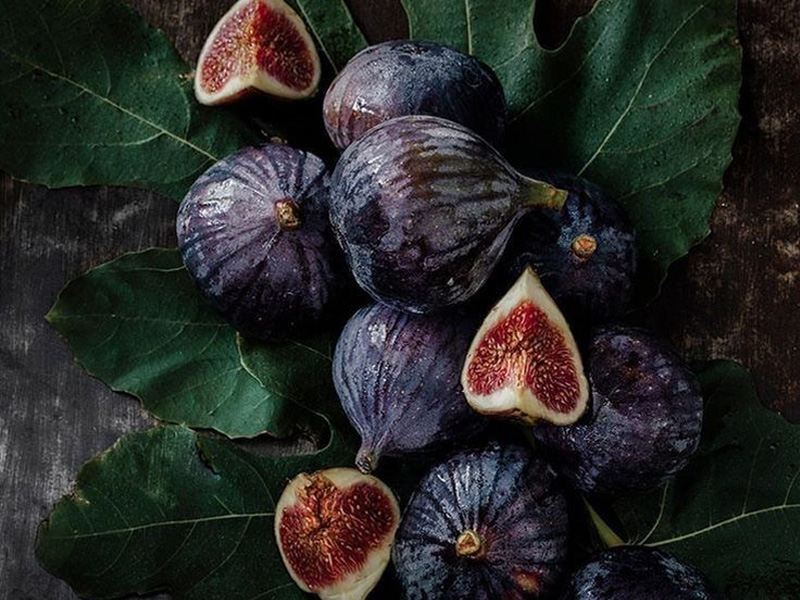
Appearance: The Mediterranean FIG is a deciduous shrub or small tree, usually 3-10 meters tall, with grayish-brown bark and distinct skin holes. The branchlets are thick and smooth. Leaf blade is broad, palmate 3-5 lobed, the lobes are ovate, the edges with irregular blunt teeth, the surface of the leaf blade is rough, the back is puberulent, the leaf color is dark green, shiny. Inflorescence, the fruit is born in the axillary of the leaf, pear-shaped or oblate spherical, the rind is diverse in color at maturity, there are green, yellow, purple, etc., the rind surface has small white spots, the flesh is soft and waxy, mostly red or pink, and the interior is covered with many small seeds.
Plant family Genus: Ficus moraceae.
Common name: Adji, Yingri fruit, Youtan bowl, honey fruit, Wenxian fruit, etc.
Extraction parts: mainly fruit, fruit contains rich nutrients and unique aroma components.
Extraction method:
Solvent extraction method: The use of organic solvents such as ethanol, petroleum ether, etc., the effective components and aroma substances in the FIG fruit are dissolved and extracted, and then the solvent is removed by distillation and other methods to obtain the extract.
Supercritical carbon dioxide extraction method: using carbon dioxide in supercritical state as an extractant, it has good solubility and diffusion, can efficiently extract the active ingredients in figs, and no solvent residue, friendly to the environment.
Main chemical composition: Rich in carbohydrates (such as glucose, fructose, sucrose), protein, dietary fiber, vitamins (vitamin A, vitamin C, vitamin K, etc.), minerals (calcium, iron, potassium, magnesium, etc.), but also contains a variety of organic acids (such as malic acid, citric acid, oxalic acid) and coumarins, flavonoids, polysaccharides and other bioactive ingredients.
Main origin: Originated in the Mediterranean coastal areas, such as Turkey, Greece, Italy, Spain and other countries. At present, it is widely cultivated in the subtropical and temperate regions of the world, and the main producing areas in China are Xinjiang, Shandong, Jiangsu, Zhejiang and other places.
Aroma: It has a unique sweet aroma, rich aroma with light fruit and milk aroma, giving people a warm and sweet feeling.
Aroma concentration: Strong aroma, especially ripe figs, can smell its attractive fragrance from a certain distance.
Suitable essential oils:
Lavender essential oil: Paired with FIG aroma, it can relax and relax at the same time, add a sweet atmosphere, which can be used in aromatherapy to create a warm atmosphere.
Sandalwood essential oil: When combined to create a warm, peaceful atmosphere, often used in high-end aromatherapy products.
Neroli Essential oil: Combined with the sweetness of figs, it creates a unique smell that is fresh and sweet and can be used to lift mood.
Functional characteristics:
Promote digestion: Rich dietary fiber helps to promote intestinal motility, improve digestive function, and prevent constipation.
Enhance immunity: Contains a variety of vitamins and minerals, can provide nutrition for the body, enhance immunity.
Anti-inflammatory and detumescence: Some bioactive ingredients have anti-inflammatory effects and can ease the inflammatory response.
Beauty and beauty: Antioxidant ingredients can eliminate free radicals in the body, delay aging, and make skin smooth and elastic.
Common application:
Muscle conditioning: FIG extract is less directly used for muscle conditioning, but the nutrients in it can be taken internally to replenish energy and nutrients for the body, indirectly contributing to muscle recovery.
Immune system: Eating figs or drinking drinks made from figs can supplement nutrients and enhance the body's immunity.
Nervous system: The sweet smell of figs can stimulate the olfactory nerves, make people feel happy, and relieve anxiety, depression and other bad emotions to a certain extent.
Taboo to use:
People with allergies: Those who are allergic to figs may have allergic reactions such as tingling in the mouth, rash, and difficulty breathing after consumption, and should avoid consumption.
Diabetes patients: figs contain high sugar, diabetes patients need to be careful to eat, control intake.
Diarrhea patients: figs have a bowel laxative effect, diarrhea patients may aggravate symptoms.
